|
BULB LOG 06 --- 7th February 2007
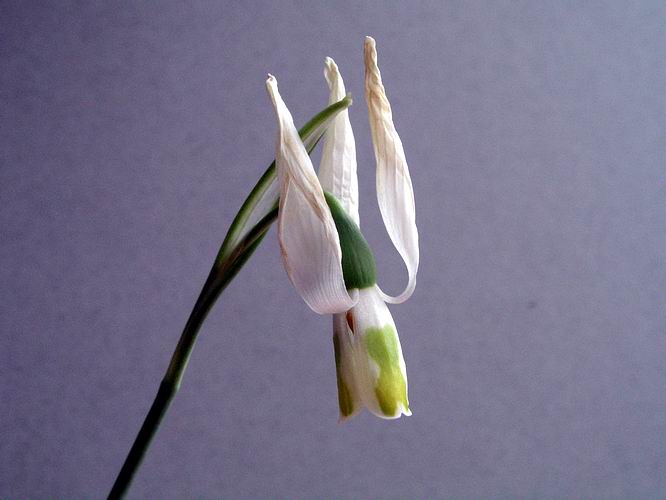
Wannabe
I hope I did not give you the wrong impression last week when I was showing you pictures of Galanthus. Even though I did admit to liking the wee white flowers I am not turning into a hopeless Galanthophile. I found out a telling truth when this snowdrop was going over: it showed me its wish - it wants to be an erythronium:-))
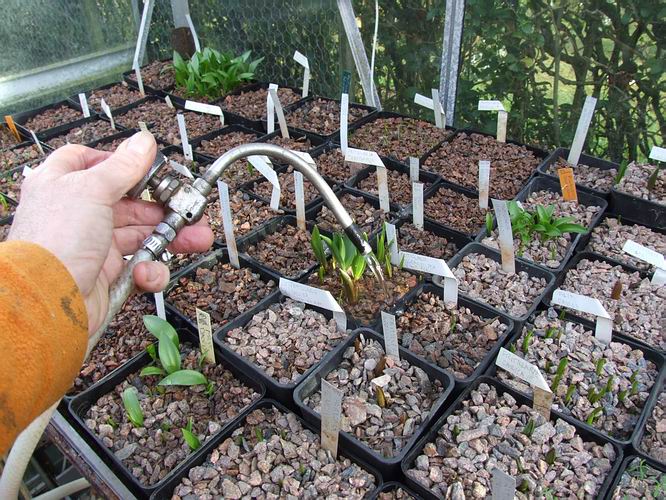
Watering the frits
Since last weeks bulb log our weather has remained bright, dry and mild for this time of year so I took advantage and watered the bulbs - especially the fritillarias which are just showing the first signs of growth above the gravel.
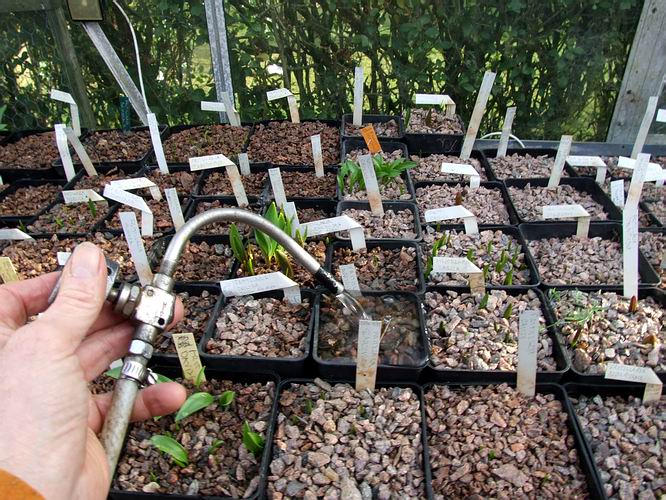
Flood the pots
I am watering all the frit pots whether they are showing shoots or not because they have not been watered at all since November or December so some of them are quite dry. As always I flood the pots with water watching to see that it drains away quickly indicating that the compost is well aerated. If any pot does not drain quickly I allow it to drain in its own time then give it another soaking and this time I would expect it to drain quickly. The reason the pots are sometimes slow to drain is that they may have become a bit too dry and the surface tension of the water resists it penetrating into the compost however, once the compost is moistened, surplus water should flow away freely.

Wet and dry
It used to be easy to tell when the pots were drying out and needing watered when I was using clay pots as you could see the difference in the colour of the clay as it lightened as it dried out. So how do you know when to water plastic pots? Firstly plastic pots need much less frequent watering, especially when the bulbs growth has not broken the surface and the only appreciable loss of moisture is through evaporation which is very slow in the winter.

When to water
One method I use to determine the moisture level is to look at the gravel and it is obvious if it is dry or wet. Another good indicator that I have is the odd weed that appears in my un-sterilised compost I can see when it is turgid or flaccid and that is why I do not remove all the weeds until the bulbs break through. Also if you can see the bed of sand that the pots are sitting on and it is moist then the pots should be moist as well. If you need to lift a pot out to see if the plunge is moist or not then it is a good idea to have a pot just filled with compost and not planted with bulbs that you can remove as a test pot. The reason for this is that if you lift a pot off the sand bed you break the capillary action between the pot and the sand and it may not be established again until you water that pot. Without the capillary action connecting it to the buffer action of the sand plunge the pot will be more at risk from the extremes of being either too wet or too dry.

Heaving gravel
A welcome sign is when the gravel top dressing heaves up into a pile as the fritillaria shoots start to extend upwards, this is another indication that the bulbs are needing a good supply of moisture and food.

Fritillaria tortifolia
The food is already in the compost as I added bone meal to the mix when the bulbs were repotted and that will provide all the nitrogen and phosphorous that the plant requires for the rapid growth of the leaves and stems it will make in the coming weeks. Fritillaria tortifolia is always among the first to take advantage of any mild spells in the winter to burst into growth. This should be no surprise as it is always one of the first to make roots which are often already starting into growth when I repot them in early July. Many of the Chinese fritillarias never want to be 100% dried out or to get too hot in the summer as that would damage these early emerging roots and if they are damaged the bulb would have to make do with its reduced roots as it can only grow one root system in a year.
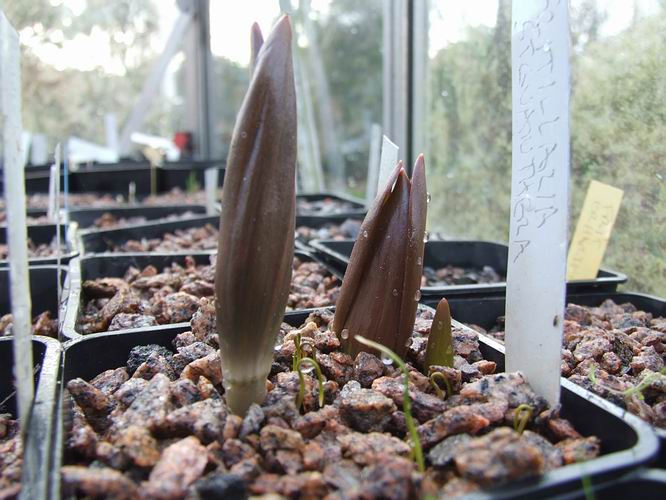
Fritillaria stenanthera and seedlings
Fritillaria stenanthera: while not such an early rooter as the Chinese species it is an early riser and is always among the first frits to flower for us. Just like other bulbs the seeds that I sowed back into the pot are germinating at precisely the same time as the bud appears through the gravel.

Crocus michelsonii
Unfortunately despite the odd bright day the sun is not high enough in the sky yet to heat up the bulb house enough to entice the crocuses to open their flowers fully. Crocus michelsonii almost opened last week but not far enough to see its stunning centre; luckily it always sends up a second flush of flowers as the first ones fade away and that is when I hope to enjoy its full beauty and get a successful pollination.

Crocus ' Bowles White'
Although we grow Crocus sieberi ' Bowles White' in the garden I always like to have a few in a pot to enjoy under glass as it has to be one of the best selections from this very variable species. It also almost opened last week and I was hopeful for some more mild conditions.

Snow falling
However the weather has other ideas as we are now back to winter snow showers. Although it is not lying for long it does lower the temperatures and keeps the skies dull - not what I want for the crocus.

Crocus sieberi and abantensis
With many Crocus species poised to open I think that they are emerging too early for our conditions, however, a quick check back through my picture files for the last five years reassures me that they are all within a day or two of the same stage as they have been since I started the bulb log, check back the logs for yourself. Log 7 is when the Crocuses start to open better so I will be patient.
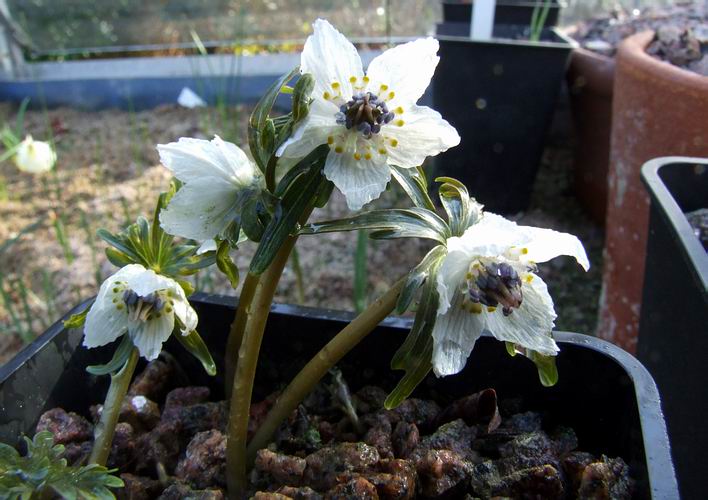
Eranthis pinnatifida
When checking the outside frame I found Eranthis pinnatifida flowering away despite the snow falling it is so delicate looking but in reality it is a tough little plant just like the other eranthis that are also opening in the garden.

Eranthis pinnatifida and hyemalis
What a beautiful colour combination the flowers of Eranthis pinnatifida display, I am glad that I moved it inside to enjoy for a few days as its more common but also very welcome cousin, Eranthis hyemalis has to suffer the snow.
^ back to the top ^
|

